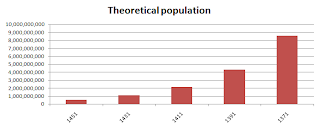Let us assume that we collected data on the presence or absence of a trait (e.g., propensity toward risky behavior) in a population of individuals, as well as on intermediate effects of the trait, downstream effects on mating and survival success, and ultimately on reproductive success (a.k.a. “fitness”, in evolutionary biology).
The data would have been collected over several generations. Let us also assume that we conducted a multivariate analysis on this data, of the same type as the analyses employing WarpPLS that were discussed here in previous posts (
). The results are summarized through the graph below.

Each of the numbers next to the arrows in the graph below represents the strength of a cause-effect relationship. The number .244 linking “a” and “y” means that a one standard deviation variation in “a” causes a .244 standard deviation increase in “y”. It also means that a one standard deviation variation in “a” causes a 24.4 percent increase in “y” considering the average “y” as the baseline.
This type of mathematical view of evolution may look simplistic. This is an illusion. It is very general, and encompasses evolution in all living organisms, including humans. It also applies to theoretical organisms where multiple (e.g., 5, 6 etc.) sexes could exist. It even applies to non-biological organisms, as long as these organisms replicate - e.g., replicating robots.
So the trait measured by “a” has a positive effect on the intermediate effect “y”. This variable, “y” in turn has a negative effect on survival success (“s”), and a strong one at that: -.518. Examples: “a” = propensity toward risky behavior, measured as 0 (low) and 1 (high); and “y” = hunting success, measured in the same way. (That is, “a” and “y” are correlated, but “a”=1 does not always mean “y”=1.) Here the trait “a” has a negative effect on survival via its intermediate effect on “y”. If I calculate the total effect of “a” on “w” via the 9 paths that connect these two variables, I will find that it is .161.
The total effect on reproductive success is positive, which means that the trait will tend to spread in the population. In other words, the trait will evolve in the population, even though it has a negative effect on survival. This type of trait is what has been referred to as a “costly” trait (
).
Say what? Do you mean to say that we have evolved traits that are unhealthy for us? Yes, I mean exactly that. Is this a “death to paleo” post? No, it is not. I discussed this topic here before, several years ago (
). But the existence of costly traits is one of the main reasons why I don’t think that mimicking our evolutionary past is necessarily healthy. For example, many of our male ancestors were warriors, and they died early because of that.
What type of trait will present this evolutionary pattern – i.e., be a costly trait? One answer is: a trait that is found to be attractive by members of the other sex, and that is not very healthy. For example, a behavior that is perceived as “sexy”, but that is also associated with increased mortality. This would likely be a behavior prominently displayed by males, since in most species, including humans, sexual selection pressure is much more strongly applied by females than by males.
Examples would be aggressiveness and propensity toward risky behavior, especially in high-stress situations such as hunting and intergroup conflict (e.g., a war between two tribes) where being aggressive is likely to benefit an individual’s group. In warrior societies, both aggressiveness and propensity toward risky behavior are associated with higher social status and a greater ability to procure mates. These traits are usually seen as male traits in these societies.
Here is something interesting. Judging from our knowledge of various warrior societies, including American plains Indians societies, the main currency of warrior societies were counts of risky acts, not battle effectiveness. Slapping a fierce enemy warrior on the face and living to tell the story would be more valuable, in terms of “counting coup”, than killing a few inexperienced enemy warriors in an ambush.
Greater propensity toward risky behavior among men is widespread and well documented, and is very likely the result of evolutionary forces, operating on costly traits. Genetic traits evolved primarily by pressure on one sex are often present in the other (e.g., men have nipples). There are different grades of risky behavior today. At the high end of the scale would be things that can kill suddenly like race car driving and free solo climbing (
,
). (If you'd like to know the source of the awesome background song of the second video linked, here it is: Radical Face's "Welcome Home".)
One interesting link between risky behavior and diet refers to the consumption of omega-6 and omega-3 fats. Risky behavior may be connected with aggressive behavior, which may in turn be encouraged by greater consumption of foods rich in omega-6 fats and avoidance of foods rich in omega-3 fats (
,
). This may be behind our apparent preference for foods rich in omega-6 fats, even though tipping the balance toward more foods rich in omega-3 fats would be beneficial for survival. We would be "calmer" though - not a high priority among most men, particularly young men.
This evolved preference may also be behind the appeal of industrial foods that are very rich in omega-6 fats. These foods seem to be particularly bad for us in the long term. But when the sources of omega-6 fats are unprocessed foods, the negative effects seem to become "invisible" to statistical tests.


 :.
:.

 1:23 PM
1:23 PM
 Unknown
Unknown














